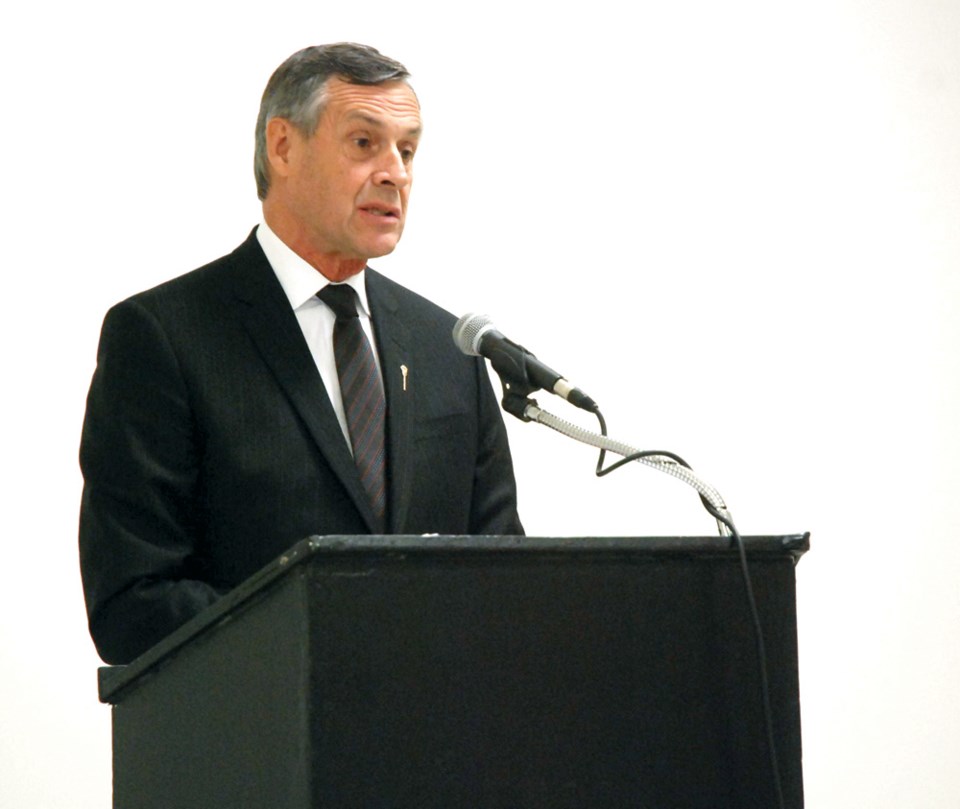The Humboldt & District Chamber of Commerce hosted another luncheon on Feb. 20 whereby Minister Don Morgan come to the city to talk about labour relations, workplace safety, and education.
Of the topics covered, Morgan also talked about the recent Supreme Court decision that made it so that the right to bargain collectively and the right for a worker to withdraw his or her services is now constitutionally protected. Since the provincial government made a commitment that residents wouldn’t be denied essential services, they came into conflict with this decision. This means that the provincial government is limited in their options.
“So we have to work very carefully to try and come up with a method or alternatively, and you may have noticed … that there is a provision in the Charter called the notwithstanding clause,” said Morgan. “I won’t bore you with legalese, but it says it’s open to the legislature and the province of Canada to say, ‘We are passing this law and … we wish to exercise our right to overrule what the courts say.’ This is something that can’t be challenged by the courts.”
If the province exercises this clause, it will only remain in effect for the next five years, during which time the citizens can deliberate on whether or not they want it. According to Morgan, that clause has only been used a handful of times because it’s regarded as a very heavy-handed method. If they decide not to use it, they will have to modify the alternative bill they had previously drawn up in order to maintain essential services in the event of a strike without superseding workers’ right to strike.
“The commitment we’ve made and continue to make means to ensure that there are hospital rooms, that there are snow plows and the things that we need to keep the citizens of our province safe and secure,” he said. “So we have made that commitment and we will live up to it and work our way through the things we need to do that.”
Since the decision was only handed down a couple of weeks ago, the provincial government has been given a year in which to deal with it. If they choose to introduce a new bill, it would only get voted on after the one-year deadline, which means they’d have to get an extension. Furthermore, since the federal and provincial elections are around that time, this makes deliberations for the provincial government somewhat difficult.
Prior to that tricky subject, Morgan also talked about topics relating to safety such as the asbestos registry. While it was introduced last year, the registry is only mandatory for publicly owned buildings and schools, universities, hospitals, and government offices. It’s voluntary for all other facilities.
“We’ve got a website so it’ll be searchable by building or the nature of risk that’s posed so it’s a work in progress, but it’s going well,” said Morgan.
“The asbestos, if it’s encapsulated doesn’t pose a risk, but the purpose of the registry is so that a worker or contractor going into the building would know … There will likely be nothing that arises that requires the removal of it unless someone’s doing work or it’s in a fragile situation.”
Since Saskatchewan currently has the second highest workplace injury rate in the country, Morgan said there are efforts to increase education around safety. There are higher health and safety penalties for noncompliance and there’s a focus on higher incident employers. The province is working with those employers to develop “safety improvement plans.”
“We know that there’s an aspect of training, but the reality is safety is the responsibility of everyone that’s one the job site, the workers, the employer, and everyone else that’s there,” said Morgan. “Our province has a real history of good work ethic people; they come from our province, they grew up here, they work hard - sometimes a bit too hard, too fast and safety gets set aside and they’ve got to do a better job.”
Finally, Morgan talked about how education will work towards the province’s goal of bringing in 60,000 workers by 2020. High schools are preparing their students for post-secondary education while colleges and universities are building closer ties with employers.
According to Morgan, Saskatchewan’s student population is growing. Forty new schools have been built since they formed government, and there are new joint-use schools, including the high school in Humboldt. Over the last several years, over $35 million has been invested into upgrades and repairs for schools in Humboldt (such as the Humboldt Public School) and in the surrounding area such as in Muenster, Bruno, and Middle Lake. All of this is geared towards bring young families to Saskatchewan and encouraging them to stay here, grow up here, and work here.
“There’s several things that come into play: we know the demand is there for the workers. Our preferred goal is to have people that are from Saskatchewan originally,” said Morgan. “Those are the ones that are here, those are the ones that aren’t going to go back when their job is done, so we want to do what we can to bring those people on stream.”
Lastly, Morgan briefly mentioned how the new labour act allows for more flexible work hours and recent introduction of an annually indexed minimum wage. The new formula will allow for an automatic increase each year.
“We’re working towards creating a strong and prosperous SK, one that meets our labour needs and increases the quality of life for all Saskatchewan residents,” he said. “Regardless of what sector you represent, we know that it’s a shared goal for all of you in the room.”




